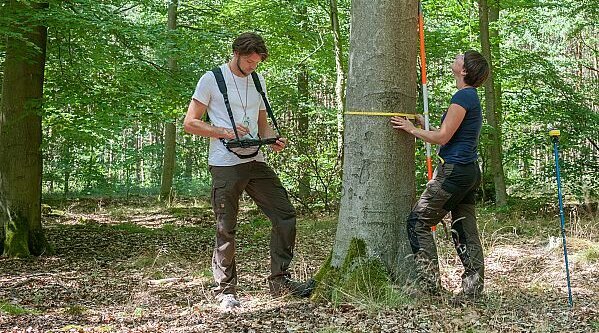Expertise
Carbon Inventory 2017 – an interim review
Thomas Riedel | 10.12.2019
Between the 2012 and 2022 National Forest Inventories, the 2017 Carbon Inventory recorded the condition of the German forest with a limited range of characteristics. It provides data on the carbon stored in the forest and shows how forests have changed since the last National Forest Inventory in 2012.

Together with the National Forest Inventory, the carbon inventory is an up-to-date data source in the area of forests for international greenhouse gas reporting based on the Framework Convention on Climate Change and the Kyoto Protocol. Its data are used to derive information on biomass and carbon storage in forests and to record changes in land use from and to forests.
In conjunction with the WEHAM forest development and wood supply model, we can assess how different scenarios affect the CO2 storage capacity of forests. In combination with climate models, we can assess the extent to which our forests can cope with climate change and where risks exist.
The methods: How the forest is measured
The 2017 Carbon Inventory is a subsample of the National Forest Inventory (NFI). Aerial photographs were analyzed at 195,630 sample points to determine if and how forest area has changed.
In the forest, approximately 30 inventory teams measured about 143,000 trees at 12,838 sample points using standardized procedures and recorded other characteristics. The amount of sequestered carbon is calculated from the determined wood volume, the tree species-specific wood density and the average carbon content.
The Carbon Inventory in the forest was carried out and evaluated by the Thünen Institute of Forest Ecosystems on behalf of the BMEL. In the process, the federal states supported the aerial photo evaluation.
Special features compared to the NFI
The legally prescribed inventory cycle of 10 years is too long to serve the information needs. Therefore, the Federal Forests Act offers in §41a (3) the option to collect data on carbon stocks in the forest in the years between two National Forest Inventories, if this is necessary to fulfill reporting obligations for climate protection. Such interim inventories were conducted in 2008 ("Inventory Study") and 2017 ("Carbon Inventory") on a subsample of the NFI. The data can be used to calculate not only carbon stock but also many other classic inventory variables such as forest area, timber stock, and timber increment.
Compared to the NFI, these interim inventories have the following special features:
- The sample density is only a quarter of the NFI base sample (8 by 8 kilometers instead of 4 by 4 kilometers). Thus, statements for federal states and other detailed questions are not possible. However, the states can condense the sample at their own expense and thus improve the data basis for state evaluations. Five federal states made use of this option for the 2017 carbon inventory.
- Only the data necessary to determine the carbon stock in the forest are collected. Therefore, some evaluations common in the National Forest Inventory are not possible. This concerns, for example, game damage, stand structure, and closeness to nature.
- The data are collected by the federal government under its own responsibility.
Most trends from previous inventory periods have continued in the period 2012 to 2017: Forest area has remained roughly constant, there are more deciduous trees, more old and thick trees, more deadwood, and a larger wood supply. Timber use remains well below increment. Thus, forests continue to be a carbon sink. Whether this remains so will be largely determined by the development of the age structure of the forests, future demand for wood and forest damage caused by extreme weather.
Key findings in brief:
- About one third of Germany's total area is forested: 11.4 million hectares.
- The most common tree species are spruce (25%), pine (23%), beech (16%), oak (19%).
- The timber stock increased by 6% from 2012 to 2017 to 3.9 billion m³.
- 117.4 million m³ of wood has been regrown per year. Three quarters have been removed by logging or natural causes, and one quarter has increased the living stock.
- The area share of deciduous trees has increased by 2%.
- There is 14% more deadwood (22.4 m³ per hectare)
- 1,230 million tons of carbon are sequestered in living trees (5% more than five years ago).
- The forest relieves the atmosphere of about 62 million tons of carbon dioxide annually. This offsets around 7% of greenhouse gas emissions in Germany.

![[Translate to English:] Logo des Bundesministerium für Ernährung und Landwirtschaft](/media/allgemein/logos/BMEL_Logo.svg)